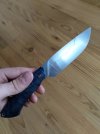- Joined
- Jan 20, 2018
- Messages
- 34
Hi there folks,
I managed to get some deep 600grit scratches into my finished highly polished blade with hamon, and now I'm trying to figure out the best way of repolishing the damn thing.
Is there a simpler solution than resanding and reetching the entire blade? And how will I go about not putting the handle scales into the acid?
If anyone has been in a similar situation and knows what to do, please feel free to let me know.
Best wishes,
Jonas

I managed to get some deep 600grit scratches into my finished highly polished blade with hamon, and now I'm trying to figure out the best way of repolishing the damn thing.
Is there a simpler solution than resanding and reetching the entire blade? And how will I go about not putting the handle scales into the acid?
If anyone has been in a similar situation and knows what to do, please feel free to let me know.
Best wishes,
Jonas

